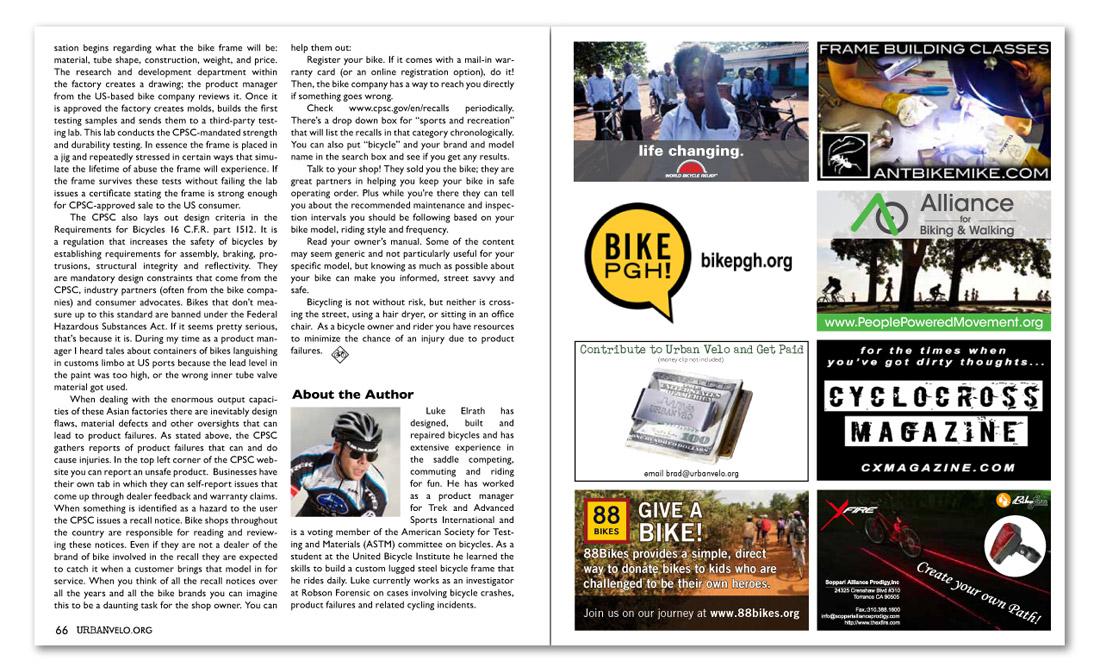


-sation begins regarding what the bike frame will be: material, tube shape, construction, weight, and price. The research and development department within the factory creates a drawing; the product manager from the US-based bike company reviews it. Once it is approved the factory creates molds, builds the first testing samples and sends them to a third-party testing lab. This lab conducts the CPSC-mandated strength and durability testing. In essence the frame is placed in a jig and repeatedly stressed in certain ways that simulate the lifetime of abuse the frame will experience. If the frame survives these tests without failing the lab issues a certificate stating the frame is strong enough for CPSC-approved sale to the US consumer.
The CPSC also lays out design criteria in the Requirements for Bicycles 16 C.F.R. part 1512. It is a regulation that increases the safety of bicycles by establishing requirements for assembly, braking, protrusions, structural integrity and reflectivity. They are mandatory design constraints that come from the CPSC, industry partners (often from the bike companies) and consumer advocates. Bikes that don’t measure up to this standard are banned under the Federal Hazardous Substances Act. If it seems pretty serious, that’s because it is. During my time as a product manager I heard tales about containers of bikes languishing in customs limbo at US ports because the lead level in the paint was too high, or the wrong inner tube valve material got used.
When dealing with the enormous output capacities of these Asian factories there are inevitably design flaws, material defects and other oversights that can lead to product failures. As stated above, the CPSC gathers reports of product failures that can and do cause injuries. In the top left corner of the CPSC website you can report an unsafe product. Businesses have their own tab in which they can self-report issues that come up through dealer feedback and warranty claims. When something is identified as a hazard to the user the CPSC issues a recall notice. Bike shops throughout the country are responsible for reading and reviewing these notices. Even if they are not a dealer of the brand of bike involved in the recall they are expected to catch it when a customer brings that model in for service. When you think of all the recall notices over all the years and all the bike brands you can imagine this to be a daunting task for the shop owner. You can help them out:
Register your bike. If it comes with a mail-in warranty card (or an online registration option), do it! Then, the bike company has a way to reach you directly if something goes wrong.
Check www.cpsc.gov/en/recalls periodically. There’s a drop down box for “sports and recreation” that will list the recalls in that category chronologically. You can also put “bicycle” and your brand and model name in the search box and see if you get any results.
Talk to your shop! They sold you the bike; they are great partners in helping you keep your bike in safe operating order. Plus while you’re there they can tell you about the recommended maintenance and inspection intervals you should be following based on your bike model, riding style and frequency.
Read your owner’s manual. Some of the content may seem generic and not particularly useful for your specific model, but knowing as much as possible about your bike can make you informed, street savvy and safe.
Bicycling is not without risk, but neither is crossing the street, using a hair dryer, or sitting in an office chair. As a bicycle owner and rider you have resources to minimize the chance of an injury due to product failures.
Luke Elrath has designed, built and repaired bicycles and has extensive experience in the saddle competing, commuting and riding for fun. He has worked as a product manager for Trek and Advanced Sports International and is a voting member of the American Society for Testing and Materials (ASTM) committee on bicycles. As a student at the United Bicycle Institute he learned the skills to build a custom lugged steel bicycle frame that he rides daily. Luke currently works as an investigator at Robson Forensic on cases involving bicycle crashes, product failures and related cycling incidents.